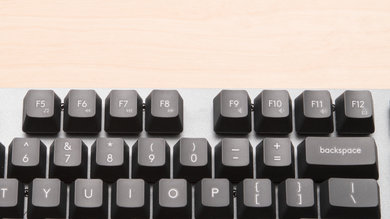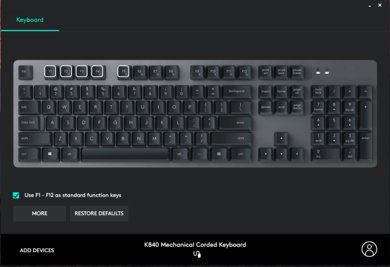The Logitech K840 is decent for office use. It's a basic keyboard that's aimed for office use for those who prefer mechanical switches, so it doesn't have the extra gaming features that you normally find on higher-end mechanical options. It lacks any backlighting, and you can only reprogram a few function keys to a preset list of commands. Still, the proprietary Romer-G tactile switches are light to press and offer a good typing experience. Even though it doesn't have a wrist rest, typing feels comfortable, and you shouldn't feel tired after long sessions.
Our Verdict
The Logitech K840 is okay for gaming. While the Romer-G tactile switches are fine for gaming and it has low latency, you can't set macros to any key. There's also no backlighting, and Logitech's software can only save one profile of settings. The rattling of the Spacebar and Shift keys may be annoying for some while gaming.
-
Romer-G tactile switches are light to press.
-
Very low latency.
-
Can't set macros to any key.
-
No backlighting.
The Logitech K840 isn't compatible with mobile devices.
The Logitech K840 is decent for office use. The Romer-G switches provide good tactile feedback and a comfortable typing experience, but if you need extra support for your wrists, it doesn't come with a wrist rest. The keyboard is generally well-built; however, the cheap quality keycaps can gather oil easily and develop shine over time. Also, the printed key legends can fade or chip off with regular use.
-
Romer-G tactile switches are light to press.
-
One incline setting and keyboard profile isn't very high.
-
Doesn't have a wrist rest.
-
Cheap-feeling keycaps.
The Logitech K840 is disappointing for programming. Although the typing experience should satisfy most people, the lack of programmable keys and the basic functionality of Logitech's software is inadequate. Its ergonomics are also just okay as it lacks a wrist rest, and there's no backlighting.
-
Romer-G tactile switches are light to press.
-
One incline setting and keyboard profile isn't very high.
-
Can't set macros to any key.
-
No backlighting.
-
Doesn't have a wrist rest.
The Logitech K840 is bad for home theatre PC use, and it's not intended for this. It can only be connected to devices via wired connection, so you have to place the keyboard close to the TV. Also, it lacks a trackpad and doesn't have backlighting if you want to use it in a dark room.
-
No backlighting.
-
Wired-only.
- 6.9 Gaming
- 3.1 Mobile/Tablet
- 7.4 Office
- 5.9 Programming
- 3.2 Entertainment / HTPC
Changelog
- Updated Dec 15, 2022: Updated the review to change the product name to Logitech K840.
- Updated Aug 03, 2021: Updated review for accuracy and clarity.
- Updated Mar 31, 2021: Converted to Test Bench 1.0.
- Updated Jan 20, 2020: Review published.
Check Price
Differences Between Sizes And Variants
We tested the Logitech K840 with Romer-G tactile switches, and there's no other variant available. If you have this keyboard and it's different from ours, let us know and we'll update the review.
Compared To Other Keyboards
The Logitech K840 is an entry-level mechanical keyboard that doesn't have the same features found on other higher-end, more expensive gaming keyboards. It doesn't have backlighting like the Logitech K845, and you can't set macros to any key. It's cheap and it's fairly well-built, so if you need a basic mechanical keyboard, this is a good choice.
Also, see our recommendations for the best mechanical keyboards, the best cheap mechanical keyboards, and the best Logitech keyboards.
The SteelSeries Apex Pro is significantly better than the Logitech K840. The SteelSeries has doubleshot keycaps, which means that the key legends are unlikely to fade or chip with daily use, and it has full RGB backlighting. There's also a fully customizable OLED screen that lets you access various settings. SteelSeries' software is feature-rich, and the omnipoint switches allow you to choose your preferred pre-travel distance.
The Logitech K840 is significantly better than the HyperX Alloy Core RGB. The Logitech has a better build quality thanks to its aluminum plate, and it has mechanical switches that feel light and responsive. The Logitech has software support for customization, but it doesn't have dedicated media keys like the HyperX, and typing noise can be louder if you bottom out the keys.
The HyperX Alloy FPS Pro is much better than the Logitech K840. The HyperX has a significantly better build quality and backlighting, while the Logitech doesn't have backlighting and has cheap pad printed keycaps. The HyperX's Cherry MX Red switches provide a much better typing experience compared to Logitech's Romer-G switches, but the Logitech has software support and programmable keys.
The Logitech G413 is a better keyboard than the Logitech K840. The G413 has backlighting and has some macro programmable keys, even though it's only limited to the function keys. Overall, the Logitech G413 is pretty much the best option.
The Logitech K840 and the Logitech K845 are both decent office keyboards. The K845 feels better built, its Cherry MX Blue switches require a bit more force to actuate, and it has backlighting. However, our K840 unit is fully compatible with macOS, and while it has customization software, there aren't many options.
Test Results
The build quality is decent. The plastic chassis and aluminum base plate flex a bit, and it's prone to scratching. The ABS keycaps feel cheap, and the pad-printed symbols may fade out over time. The alphanumeric keys are fairly stable, but there's a bit of wobble to them. However, the larger keys rattle easily and produce a spring-like noise when pressed. You can even hear the keys rattle if you shake the keyboard. Lastly, there are rubber grips underneath the keyboard, but it still slides around easily during use. However, it's more stable if you extend the incline feet.
The Logitech K840 has okay ergonomics. It's a basic, straight keyboard that sits nearly flat against the table if you don't use the incline feet. The keyboard still feels comfortable to use if you have the incline feet extended, and even though it doesn't come with a wrist rest, you shouldn't feel any fatigue.
The Logitech K840 doesn't have backlighting, which makes this keyboard unsuitable for dark rooms. If you need backlighting, you can check out the red backlit Logitech G413 or the Logitech G512 Special Edition, which has full RGB backlighting.
The standard rubber cable feels strong but isn't detachable.
The Logitech K840 can't be used wirelessly.
There are very few extra features on this keyboard. It has media control hotkeys, as well as some shortcuts for apps, like mail and calculator. Out of the box, F1 through F12 are function keys by default, but this can be changed within Logitech's Options software to have the media controls as the default. Unfortunately, you can't set macros to any key, but you can reprogram a few of the function keys to a preset list of functions. One element that's oddly missing is a Num Lock LED indicator. That said, if you have Logitech's Options software installed, an on-screen pop up will let you know when it has been activated.
If you need more features like dedicated media controls or macro programmable keys, check out the SteelSeries Apex 5.
The Logitech K840 uses Romer-G tactile switches, which are similar to Cherry MX Brown switches, but have shorter pre-travel, and the tactile bump isn't as pronounced. Still, it delivers a light and responsive typing experience.
The typing quality is good. Logitech's Romer-G switches are responsive and provide a light tactile bump that lets you know when a key has been actuated, but some may find them a bit mushy. It requires very little force to type, and the actuation point is lower than standard Cherry MX switches, which can sometimes cause unintended keystrokes. Unfortunately, the stabilizers used on certain keys feel rather cheap, as these keys wobble and rattle a lot; this is especially noticeable on the Spacebar, Backspace, Enter, and Shift keys.
If you want a keyboard that provides a better typing experience, check out the Ducky Shine 7.
Overall, the typing noise is fairly quiet, but the Spacebar, Backspace, Enter, and Shift keys wobble a lot, adding a clicky metallic sound to those keys.
The Logitech K840 has incredibly low latency, and you won't notice any delay.
The Logitech Options software is bad. It's available for Windows and macOS, but the software feels pretty barebones. It lets you remap F1 through F5, but only to a limited list of presets. It also allows you to choose between having F1 through F12 as standard function keys or as dedicated media keys. There isn't onboard memory, but you can save your settings to the cloud sync feature if you create an account.
The Logitech K840 has good compatibility. The Logitech Options software is available for Windows and macOS, but not for Linux. All the keys function properly on Linux, but you won't be able to customize it in any way.
Comments
Logitech K840: Main Discussion
Let us know why you want us to review the product here, or encourage others to vote for this product.






























